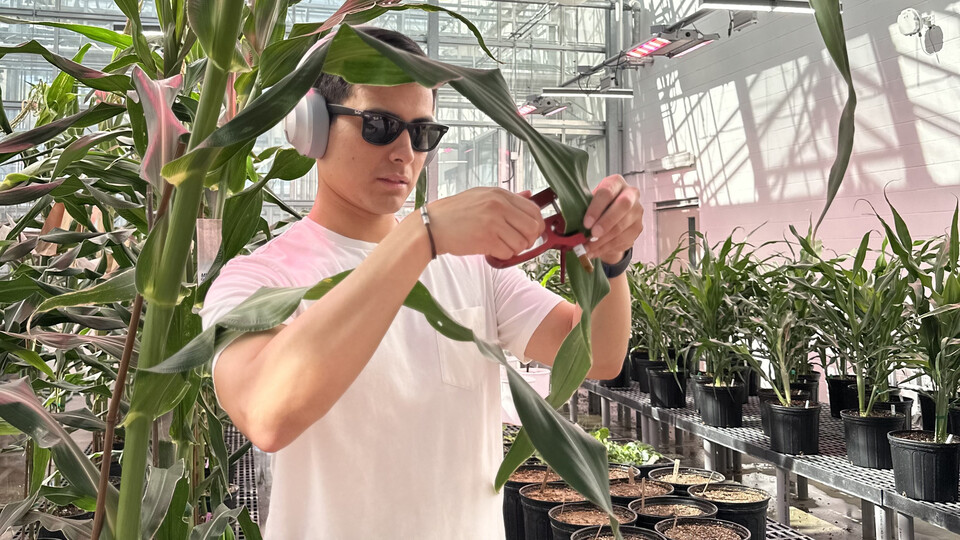Nebraska researchers received a $650,000 grant from the U.S. Department of Energy to develop an innovative RNA-based approach to predicting the success of corn hybrids in new environments.
This research, detailed in a University of Nebraska-Lincoln (UNL) news release, aims to enhance the productivity and resilience of corn crops, providing valuable insights for the future of agriculture.
The secured funding from the U.S. Department of Energy (DOE) to develop an approach to predicting how well corn hybrids will perform in new environments. Researchers believe this work is a crucial step toward creating new crop varieties that outperform current standards.
Plant scientist James Schnable’s team is using the DOE grant to expand on a study his team published earlier this summer. Their research initially showed that an RNA-based method could be more effective than existing DNA-based techniques for identifying the functions of corn genes and predicting the plants’ physical traits.
More from Seed World on the early phases of this research
With this new funding, Schnable’s team will test whether the initial results, obtained from trials in Nebraska and Michigan, apply to data from the latest hybrid varieties grown across the country. The team will collaborate with researchers in Nebraska and five other states to gather RNA data, refine a predictive model, and compare its outcomes with those produced by leading DNA-based methods.
This next phase marks the largest study to date focusing on an RNA-based approach for corn gene identification and trait prediction. It is essential for turning the team’s scientific breakthrough into a commercially viable product that can benefit farmers in Nebraska and beyond.
“By testing across many environments with genetics relevant to farmers, we aim to turn a fundamental discovery into a technology that people can actually use,” Schnable said in the release.
This research could help meet the demand for increased corn productivity and efficiency, especially as a rapidly changing environment—characterized by longer growing seasons, fluctuating rainfall patterns, and new regulations on nitrogen pricing and herbicides—complicates predictions about which hybrids will be best for commercialization in the future.
“We face a significant challenge in corn breeding: it still takes seven to ten years to develop a new hybrid, from initial field tests to getting a variety into farmers’ hands,” he said. “If we can create better ways to predict which hybrids will thrive in new environments before testing them, we can both shorten that cycle and improve our development and release of hybrids that will yield high and remain resilient in Nebraska’s environment of 2030 or 2035, instead of making future farmers use hybrids designed for the Nebraska of 2020 or 2024.”
Vladimir Torres-Rodriguez, a postdoctoral associate in the Schnable Lab, developed and tested a novel gene-analysis method that focuses on RNA, significantly enhancing the ability to identify corn genes. This work, featured in a study published earlier this year, attracted additional federal funding to broaden the study.
In the project’s first phase, Schnable and Vladimir Torres-Rodríguez overcame a longstanding challenge in using an RNA-based technique for gene identification: capturing RNA data from hundreds of corn plants quickly enough to ensure consistency was considered nearly impossible due to daily fluctuations in RNA values. Jonathan Turkus, a research manager at the Center for Plant Science Innovation, helped the team solve this issue.
Using tools fabricated at Nebraska Innovation Studio, the makerspace at Nebraska Innovation Campus, Turkus enabled the team to collect over 2,500 samples from nearly 700 corn varieties and immediately flash-freeze them, all within about two hours. This effort produced the world’s largest dataset of RNA levels measured in different plants in a single experiment. The new sampling instruments designed and built by Turkus were key to unlocking RNA’s potential in gene function analysis, according to Schnable.
Torres-Rodríguez led the development of a statistical framework that links RNA values to gene function. Collaborating with private-sector partners, they employed machine learning and AI techniques to create a model that uses RNA data to predict plant properties.
The results were promising: the RNA-based model identified about ten times more corn genes influencing flowering time than widely used DNA-based methods. However, the study needed to be more extensive to attract private company funding, as they wanted to see the model’s effectiveness across diverse environments and its ability to predict grain yield and other crucial traits in corn hybrids similar to those grown today.
With new funding, the team will address these challenges. They will use corn hybrids that recently went off-patent, which are the closest to what Nebraska farmers currently use and are available for unrestricted research.
The team will partner with the Genomes to Fields Initiative to collect RNA data from a wide range of states, including Nebraska, Michigan, Missouri, North Carolina, South Carolina, and Georgia.
This data will be used to further train their RNA-based prediction models and test how they compare to DNA-based models developed by leading experts in plant phenotype prediction. This is part of the Genomes to Fields yield prediction contest, where researchers worldwide strive to produce the best prediction results.
If the RNA-based model outperforms traditional methods, it will be a significant step toward bringing this tool to the private sector and into the hands of plant breeders and farmers. This project offers Nebraska researchers a chance to demonstrate the real-world impact of their work.
“This award is particularly exciting because it shows a federal agency investing in Nebraska not just for new fundamental research but to translate that research into commercialization and economic impact,” Schnable said.













